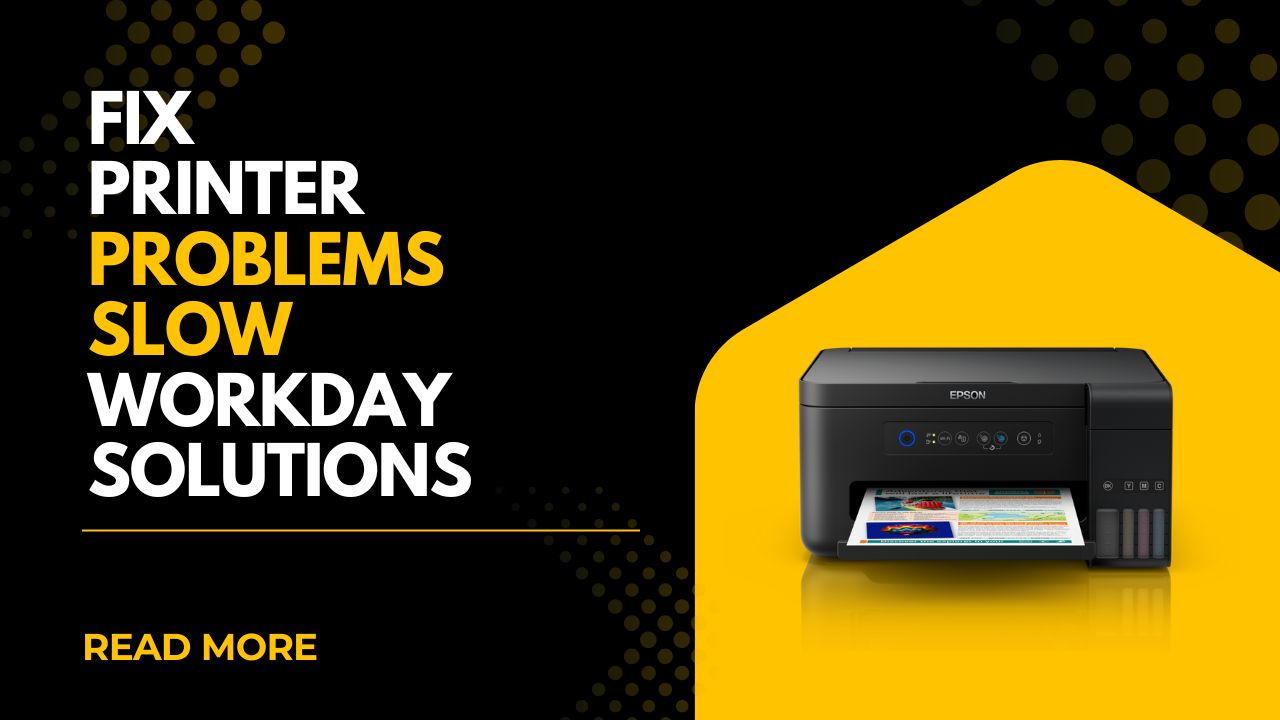Introduction
Printer problems slow workday productivity more than any other office equipment issue, turning simple document tasks into time-consuming frustrations. Whether you’re rushing to print presentation materials for an important meeting or trying to complete urgent paperwork before a deadline, printer malfunctions always seem to occur at the most inconvenient moments.
These disruptions don’t just affect individual productivity—they create ripple effects throughout the workplace. When the office printer fails, employees waste valuable time troubleshooting, searching for alternative printing solutions, or waiting in line at the one functioning device. Studies show that printer-related delays can reduce overall office efficiency by up to 30% during peak usage periods.
The financial impact extends beyond lost productivity. Emergency service calls, rushed trips to print shops, and missed deadlines due to printing delays create hidden costs that significantly impact business operations. This comprehensive guide identifies the most common printer problems that disrupt workdays and provides proven solutions to minimize downtime and restore productivity quickly.
What Are Workday-Disrupting Printer Issues?
Workday-disrupting printer issues are malfunctions that occur during critical business hours, preventing employees from completing time-sensitive tasks and meeting important deadlines. These problems differ from routine maintenance issues because they strike when printing demand is highest and alternatives are limited.
The most disruptive printer problems typically involve complete system failures, network connectivity loss, or quality issues that make documents unusable for professional purposes. Unlike minor inconveniences that can be postponed, these issues demand immediate attention because they directly impact business operations and customer commitments.
Timing makes these problems particularly damaging to workplace productivity. Morning rushes when everyone needs to print agendas and presentations, pre-meeting preparations requiring last-minute document updates, and end-of-day deadline crunches create peak demand periods when printer failures cause maximum disruption.
The psychological impact of printer problems compounds their productivity effects. Employee frustration, stress from missed deadlines, and the anxiety of unreliable equipment create negative workplace dynamics that extend far beyond the immediate printing delay. Understanding these broader impacts helps prioritize effective solutions that restore both functionality and workplace confidence.
Modern workplace dependencies on immediate document access make printer reliability crucial for maintaining professional standards and meeting client expectations in today’s fast-paced business environment.
6 Major Printer Problems That Kill Workplace Productivity

1. Network Connection Failures During Peak Hours
Network printer disconnections during busy periods create bottlenecks that affect entire teams simultaneously.
Immediate Action Steps:
- Check if other network devices are functioning to isolate the problem
- Restart the printer and wait for complete boot-up before testing
- Verify the printer’s IP address hasn’t changed due to network updates
- Test wired connection temporarily if wireless is failing
- Contact IT support immediately if multiple devices lose connectivity
- Implement backup printing options for critical documents
Prevention Strategy: Set up static IP addresses for office printers and schedule network maintenance during off-hours to prevent peak-time disruptions.
2. Paper Jams at Critical Moments
Paper jams seem to occur precisely when deadlines are tightest and stress levels are highest.
Quick Resolution Process:
- Turn off the printer immediately to prevent damage
- Remove paper in the direction of normal paper flow
- Check for torn fragments using a flashlight
- Examine paper quality and loading procedures
- Test with fresh paper before resuming normal operations
- Document recurring jam locations for maintenance scheduling
Long-term Solution: Train all employees on proper paper loading techniques and establish quality standards for office paper supplies.
3. Slow Printing Speeds That Create Bottlenecks
When printers process jobs slowly, queues build up and employees waste time waiting for documents.
Speed Optimization Techniques:
- Change default settings to “Fast” or “Draft” mode for routine documents
- Reduce image resolution for documents that don’t require high quality
- Print multiple copies in single jobs rather than repeated individual prints
- Update printer drivers to latest versions for performance improvements
- Clear print queues regularly to prevent processing delays
- Consider upgrading to higher-capacity printers for high-volume needs
4. Toner and Ink Issues During Rush Periods
Running out of consumables during critical printing periods creates immediate productivity crises.
Supply Management Solutions:
- Monitor toner levels daily and maintain emergency backup supplies
- Ignore false “low toner” warnings but act on legitimate depletion alerts
- Keep installation instructions posted near printers for quick replacement
- Establish relationships with local suppliers for emergency deliveries
- Train multiple employees in cartridge replacement procedures
- Set up automatic reordering based on usage patterns

5. Print Quality Problems for Important Documents
Poor print quality makes documents unusable for client presentations and professional communications.
Quality Control Measures:
- Run weekly test prints to identify quality degradation early
- Perform head cleaning cycles at first sign of streaking or fading
- Use appropriate paper grades for different document types
- Calibrate color settings monthly for consistent professional output
- Replace imaging components before complete failure occurs
- Maintain separate high-quality printer for critical documents
6. Driver Conflicts and Software Errors
Software-related printer problems often appear without warning and affect multiple users simultaneously.
Technical Resolution Steps:
- Update all printer drivers across connected computers
- Restart print spooler services on affected workstations
- Clear corrupted print jobs from system queues
- Reinstall printer software if conflicts persist
- Check for operating system updates that affect printer compatibility
- Document successful solutions for future reference

Advanced Productivity Tools for Printer Management
Modern printer management software provides proactive monitoring capabilities that prevent productivity-killing problems before they occur. These systems track usage patterns, predict maintenance needs, and send alerts when supplies run low, eliminating surprises that disrupt workdays.
Cloud-based monitoring solutions enable remote troubleshooting that can resolve many issues without physical intervention. IT support can diagnose problems, clear queues, and restart services remotely, minimizing downtime and reducing the need for on-site technical visits.
Mobile printing apps allow employees to send documents to printers from anywhere in the office, reducing wait times and providing flexibility during peak usage periods. These solutions often include features like secure print release that holds documents until the user is present at the printer.
Print server solutions distribute jobs across multiple printers automatically, preventing bottlenecks at individual devices. When one printer experiences problems, jobs can be automatically redirected to functioning alternatives, maintaining productivity even during equipment failures.
Queue management systems provide real-time visibility into print job status and estimated completion times, allowing employees to plan their time more effectively and choose optimal printing windows for large jobs.
Costly Mistakes That Amplify Printer Problems Slow Workday Issues
The most expensive mistake organizations make is treating printer problems as isolated technical issues rather than productivity threats that require immediate attention. Delaying repairs or troubleshooting during business hours multiplies the productivity impact and creates employee frustration that affects overall workplace morale.
Inadequate backup planning leaves offices vulnerable to extended downtime when primary printers fail. Every office should have alternative printing options and documented procedures for accessing these resources quickly during emergencies. Relying on a single printer for critical operations guarantees productivity disruptions.
Poor supply management creates artificial emergencies when consumables run out during peak demand periods. Waiting until supplies are completely depleted before reordering guarantees printing delays during critical business operations. Maintaining adequate inventory and backup supplies prevents these predictable disruptions.
Ignoring early warning signs allows minor issues to develop into major problems that require extended repair time. Strange noises, declining print quality, and intermittent errors indicate developing problems that can be resolved quickly if addressed promptly. Waiting for complete failure ensures maximum disruption to workplace productivity.
Lack of employee training creates situations where simple problems become major disruptions because no one knows how to implement basic solutions. Training multiple employees in fundamental troubleshooting procedures ensures that minor issues can be resolved quickly without waiting for technical support.
Frequently Asked Questions
Q: How can I prevent printer problems from disrupting important meetings and presentations? A: Print critical documents well in advance of meetings, maintain backup copies in digital format, and identify alternative printing locations in your building. Consider keeping a backup portable printer for emergency situations.
Q: What should I do when the office printer fails during peak hours and IT support isn’t immediately available? A: Follow basic troubleshooting steps (restart, check connections, clear paper jams), maintain a list of nearby print services for emergencies, and designate trained employees who can handle common problems quickly.
Q: How often should we replace printer components to prevent workday disruptions? A: Replace consumables before they’re completely depleted, follow manufacturer recommendations for maintenance intervals, and track usage patterns to predict component replacement needs before failures occur.
Q: Are there warning signs that indicate a printer problem is developing that could slow down our workday? A: Watch for declining print quality, unusual noises, frequent paper jams, slow processing speeds, and intermittent connectivity issues. Address these early warning signs promptly to prevent major disruptions.
Conclusion
Understanding and preventing printer problems slow workday issues is essential for maintaining workplace productivity and meeting business deadlines consistently. The solutions outlined in this guide provide practical approaches to the most common printing disruptions that affect professional environments.
Proactive printer management, adequate supply inventory, and employee training create a printing environment that supports rather than hinders productivity. By implementing preventive measures and maintaining quick response procedures, organizations can minimize the impact of inevitable printer problems on daily operations.
Remember that the cost of printer downtime extends far beyond repair expenses—it includes lost productivity, missed opportunities, and employee frustration that affects overall workplace efficiency. Investing in reliable printer management strategies and backup solutions pays dividends through improved productivity and reduced stress during critical business periods. With proper preparation and systematic approaches, printer problems become minor inconveniences rather than major workday disruptions.
Common Printer Problems Office Solutions: Quick Fixes for Busy Teams Read More




